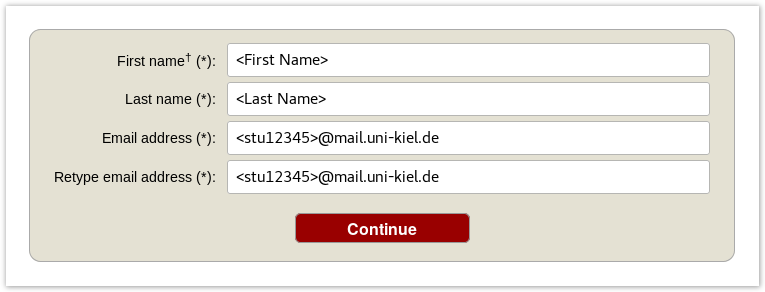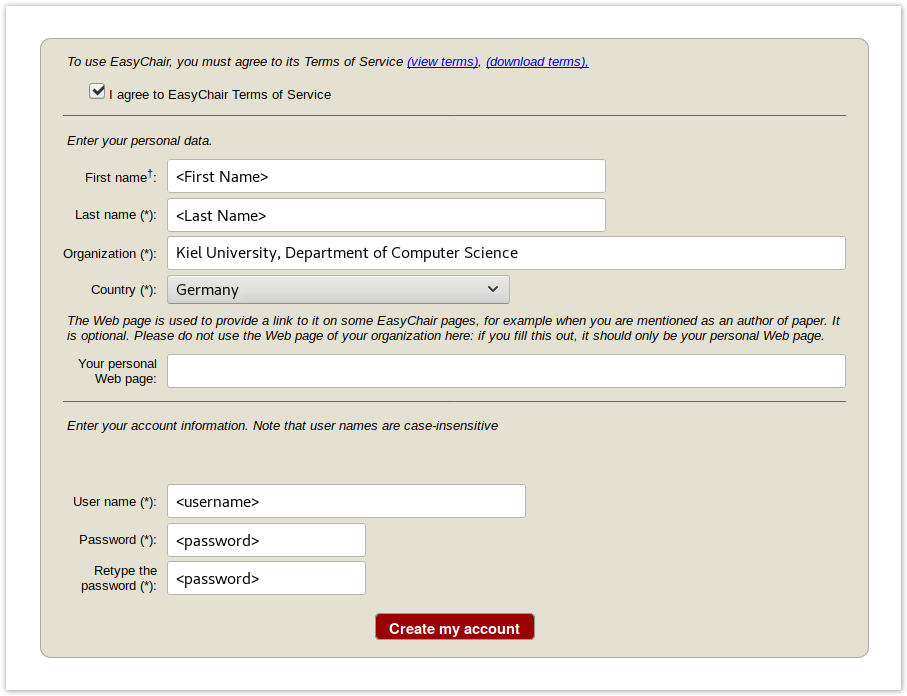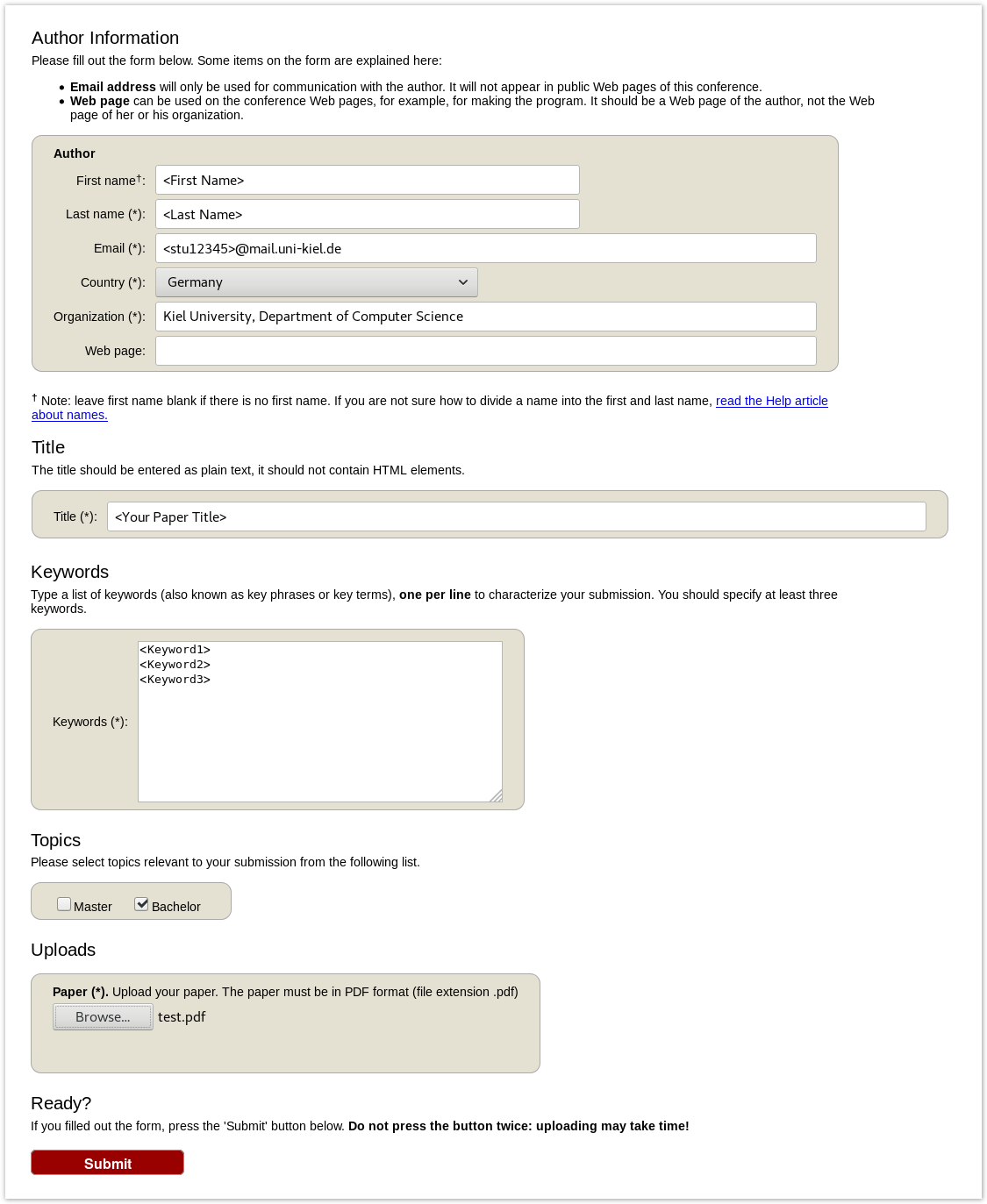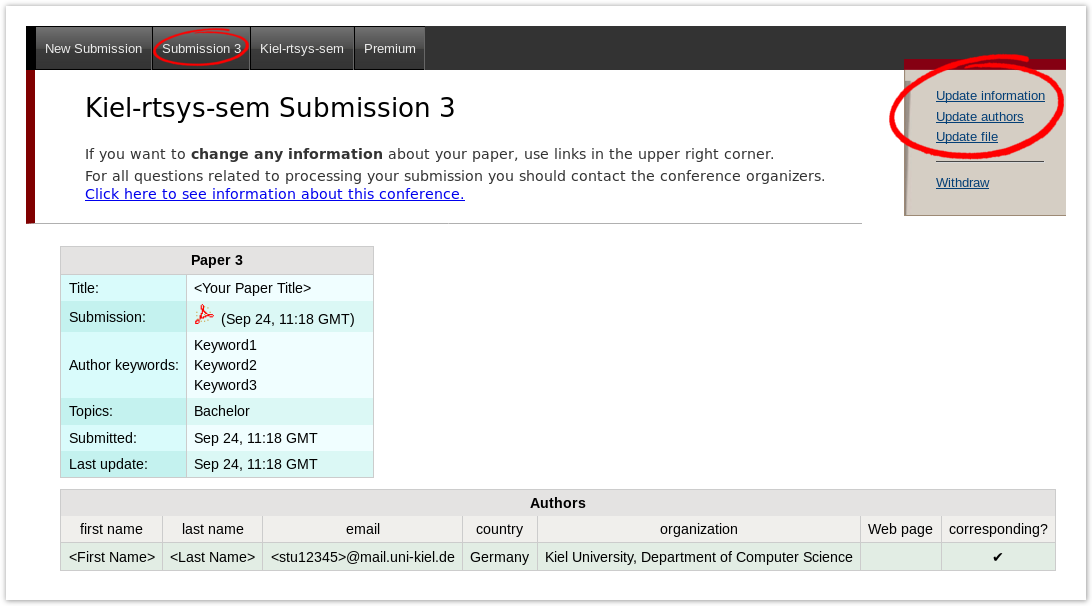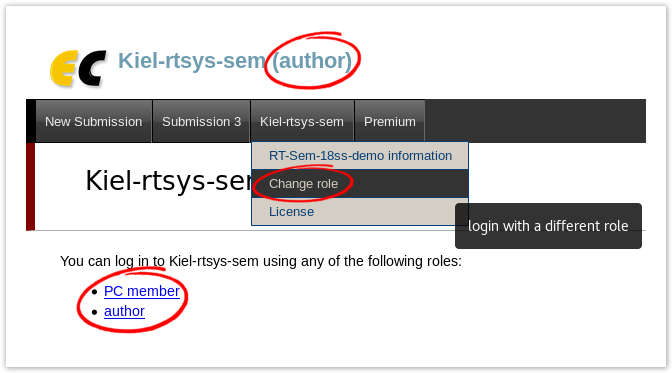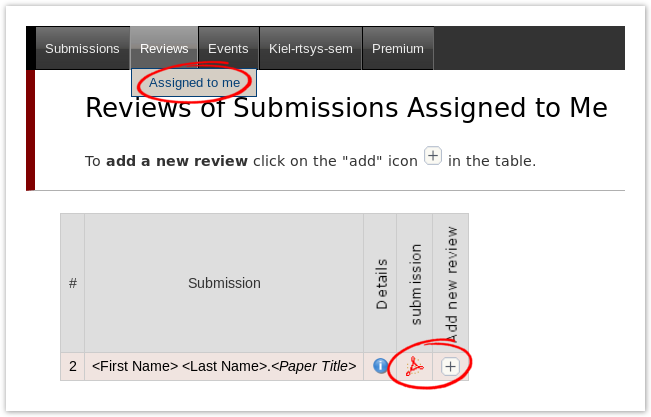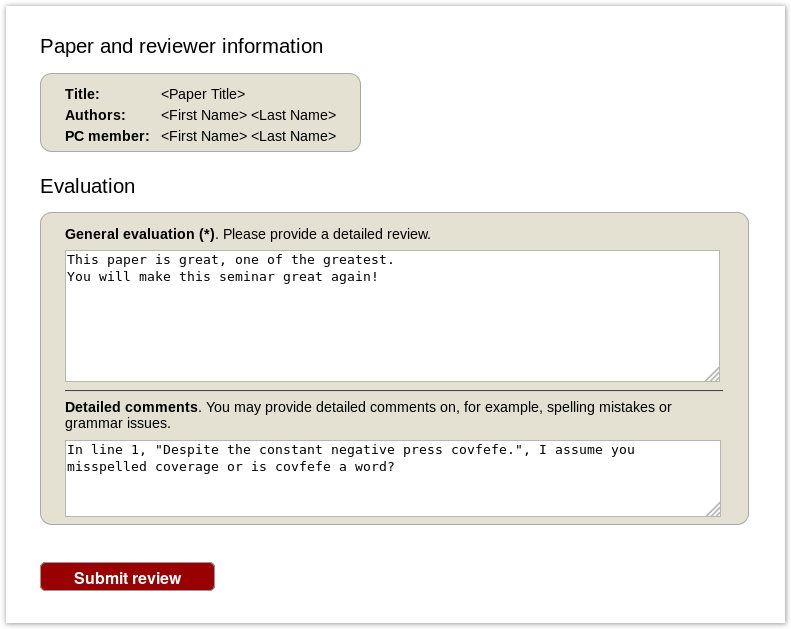The purpose of this seminar is to independently and scientifically work on a topic on synchronous languages and related. The goal is to summarize the topic in an oral presentation and a written elaboration in form of a paper. Another purpose of this seminar is to practice working in structured and time-driven workflows (e.g. for conferences or workshops). Moreover, both of these aspects are a good preparation for working on your thesis. We have many theses regarding these topics available; contact us if you are interested in that.
This seminar is a bachelor and master module at the same time. Compared to the bachelor seminar, we expect that master students include more related work and therefore write a longer paper and hold a longer presentation (see below).
Prerequisites
This seminar is build upon the contents of the "Synchronous Languages" lecture. All participants that did not yet attend this lecture are recommended to read the following introduction paper, at least parts I and II:
Benveniste, A.; Caspi, P.; Edwards, S.A.; Halbwachs, N.; Le Guernic, P.; de Simone, R., "The synchronous languages 12 years later," Proceedings of the IEEE , vol.91, no.1, pp.64,83, Jan 2003 (pdf).
Moreover, we recommend the attendance of the lecture "Scientific Working for Seminars and Thesis" (Wissenschaftliches Arbeiten für Seminar und Abschlussarbeiten) held by Mr. Mazarakis.
Lecturers
Reinhard von Hanxleden (rvh@informatik.uni-kiel.de)
Alexander Schulz-Rosengarten (als@informatik.uni-kiel.de)
Lena Grimm (lgr@informatik.uni-kiel.de)
Topics
You may choose from one of the following papers. The scope, complexity and required knowledge for these papers roughly divides them into topics for bachelor students and for master students. However, bachelor students that take great interest in a master students topic may also choose from those.
The papers are assigned via first-come-first-serve. Already taken papers are marked. Please send an email to Alexander (als@informatik.uni-kiel.de) in order to reserve a paper.
Many of the links do only work in the university network. Through the usage of a VPN or a remote session to the terminal server, those are also accessible from home. If any problems occur feel free to contact us.
Bachelor Recommendations
[assigned] A. Procter, W. Harrison, I. Graves, M. Becchi, G. Allwein, "Semantics Driven Hardware Design, Implementation, and Verification with ReWire", LCTES 2015
[assigned] Nicolas Harrand, Franck Fleurey, Brice Morin, and Knut Eilif Husa. 2016. ThingML: A language and code generation framework for heterogeneous targets. In Proceedings of the ACM/IEEE 19th International Conference on Model Driven Engineering Languages and Systems (MODELS '16). ACM, New York, NY, USA, 125-135.
Juha-Pekka Tolvanen and Steven Kelly. 2018. Effort Used to Create Domain-Specific Modeling Languages. In Proceedings of the 21th ACM/IEEE International Conference on Model Driven Engineering Languages and Systems (MODELS '18). ACM, New York, NY, USA, 235-244.
Björn Döbel, Hermann Härtig, Can We Put Concurrency Back Into Redundant Multithreading?, EMSOFT 2014
[assigned] F. Glaser, G. Haugou, D. Rossi, Q. Huang and L. Benini, Hardware-Accelerated Energy-Efficient Synchronization and Communication for Ultra-Low-Power Tightly Coupled Clusters, 2019 Design, Automation & Test in Europe Conference & Exhibition (DATE), Florence, Italy, 2019, pp. 552-557.
[assigned] Thomas Nyman, Ghada Dessouky, Shaza Zeitouni, Aaro Lehikoinen, Andrew Paverd, N. Asokan, and Ahmad-Reza Sadeghi. 2019. HardScope: Hardening Embedded Systems Against Data-Oriented Attacks. In Proceedings of the 56th Annual Design Automation Conference 2019 (DAC '19). ACM, New York, NY, USA, Article 63, 6 pages.
[assigned] Wenchen Wang, Daniel Mosse, Daniel Cole, and Jason G. Pickel. 2018. Dynamic Wireless Network Reconfiguration for Control System applied to a Nuclear Reactor Case Study. In Proceedings of the 26th International Conference on Real-Time Networks and Systems (RTNS '18). ACM, New York, NY, USA, 30-40.
Yooseong Kim, David Broman, Jian Cai, and Aviral Shrivastaval, WCET-Aware Dynamic Code Management on Scratchpads for Software-Managed Multicores, In Proceedings of the 20th IEEE Real-Time and Embedded Technology and Application Symposium (RTAS 2014), Berlin, Germany, 2014
[assigned] N. Hili, A. Girault and É. Jenn, Worst-Case Reaction Time Optimization on Deterministic Multi-Core Architectures with Synchronous Languages, 2019 IEEE 25th International Conference on Embedded and Real-Time Computing Systems and Applications (RTCSA), Hangzhou, China, 2019
[assigned] Mathijs Saey, Joeri De Koster, and Wolfgang De Meuter, Skitter: A DSL for Distributed Reactive Workflows, In Proceedings of the 5th ACM SIGPLAN International Workshop on Reactive and Event-Based Languages and Systems (REBLS 2018), New York, USA, 2018
Marten Lohstroh and Edward A. Lee, Deterministic Actors, 2019 Forum for Specification and Design Languages (FDL), Southampton, United Kingdom, 2019
[assigned] Sven Peldszus, Katja Tuma, Daniel Strüber, Jan Jürjens and Riccardo Scandariato, Secure Data-Flow Compliance Checks between Models and Code Based on Automated Mappings, 2019 ACM/IEEE 22nd International Conference on Model Driven Engineering Languages and Systems (MODELS), Munich, Germany, 2019
[assigned] Byron DeVries and Betty Cheng, Goal-Based Modeling and Analysis of Non-Functional Requirements, 2019 ACM/IEEE 22nd International Conference on Model Driven Engineering Languages and Systems (MODELS), Munich, Germany, 2019
[assigned] Betty H. C. Cheng, Bradley Doherty, Nick Polanco and Matthew Pasco, Security Patterns for Automotive Systems, 2019 ACM/IEEE 22nd International Conference on Model Driven Engineering Languages and Systems Companion (MODELS-C), Munich, Germany, 2019
Master Recommendations
Jordan A. Ross, Alexandr Murashkin, Jia Hui Liang, Micha
Carlos A. González, Mojtaba Varmazyar, Shiva Nejati, Lionel C. Briand, and Yago Isasi. 2018. Enabling Model Testing of Cyber-Physical Systems. In Proceedings of the 21th ACM/IEEE International Conference on Model Driven Engineering Languages and Systems (MODELS '18). ACM, New York, NY, USA, 176-186.
Reza Ahmadi, Ernesto Posse, and Juergen Dingel. 2018. Slicing UML-based Models of Real-time Embedded Systems. In Proceedings of the 21th ACM/IEEE International Conference on Model Driven Engineering Languages and Systems (MODELS '18). ACM, New York, NY, USA, 346-356.
Bader Alahmad and Sathish Gopalakrishnan. 2018. On Budgeting and Quality, with an Application to Safety-Critical Real-time Systems. In Proceedings of the 26th International Conference on Real-Time Networks and Systems (RTNS '18). ACM, New York, NY, USA, 19-29.
Andreas Sailer, Michael Deubzer, Gerald Lüttgen, and Jürgen Mottok. 2017. Comparing trace recordings of automotive real-time software. In Proceedings of the 25th International Conference on Real-Time Networks and Systems (RTNS '17). ACM, New York, NY, USA, 118-127.
Tobias Sehnke, Dieter Schwarzmann, Matthias Schultalbers, and Rolf Ernst. 2017. Temporal properties in automotive control software. In Proceedings of the 25th International Conference on Real-Time Networks and Systems (RTNS '17). ACM, New York, NY, USA, 98-107.
Tobias Klaus, Florian Franzmann, Matthias Becker, and Peter Ulbrich. 2018. Data Propagation Delay Constraints in Multi-Rate Systems: Deadlines vs. Job-Level Dependencies. In Proceedings of the 26th International Conference on Real-Time Networks and Systems (RTNS '18). ACM, New York, NY, USA, 93-103.
Evgeny Kusmenko, Bernhard Rumpe, Sascha Schneiders, and Michael von Wenckstern. 2018. Highly-Optimizing and Multi-Target Compiler for Embedded System Models: C++ Compiler Toolchain for the Component and Connector Language EmbeddedMontiArc. In Proceedings of the 21th ACM/IEEE International Conference on Model Driven Engineering Languages and Systems (MODELS '18). ACM, New York, NY, USA, 447-457.
Arne Hamann, Dakshina Dasari, Jorge Martinez, and Dirk Ziegenbein. 2018. Response Time Analysis for Fixed Priority Servers. In Proceedings of the 26th International Conference on Real-Time Networks and Systems (RTNS '18). ACM, New York, NY, USA, 254-264.
Guillaume Brau, Nicolas Navet, and Jérôme Hugues. 2017. Heterogeneous models and analyses in the design of real-time embedded systems - an avionic case-study. In Proceedings of the 25th International Conference on Real-Time Networks and Systems (RTNS '17). ACM, New York, NY, USA, 168-177.
Schedule
Access to Online Meetings
All registered participants have received a link via the seminar's mailing list. If you did not get the link, please contact Alexander.
| Date | Milestone |
|---|---|
| Tue. 03.11. 11:50, Online | First Meeting/Kick-Off with a Latex and EasyChair introduction. The meeting will take place online via BigBlueButton (Room links have been sent). |
| Tue. 03.11. 23:59 | Deadline for topic selection (via email to Alexander) |
| Tue. 24.11. 8:00 | Deadline of the first draft in EasyChair. This includes abstract, introduction, outline, notes for chapter contents and an overview list of bibliography for related work. |
Wed. 25.11 & Th. 26.11, Online | Individual feedback dates. The meetings will take place online via BigBlueButton. |
| Tue. 15.12. 8:00 | Deadline of the first full version (submission update in EasyChair) |
Wed. 16.12 & Th. 17.12, Online | Individual feedback dates. The meetings will take place online via BigBlueButton. |
| Tue. 12.01. 8:00 | Deadline of the review version (submission update in EasyChair) and admission to program committee (invitation via email) |
| subsequently | Review assignment (via email) |
| Tue. 19.01. 8:00 | Deadline reviews (in EasyChair) |
Wed. 03.02 & Th. 04.02, Online | Individual feedback dates on presentation slides. The meetings will take place online via BigBlueButton. The slides need to be available online or sent to the advisor beforehand (as PDF). |
| Mon. 01.03. 8:00 | Deadline final version (submission update in EasyChair) |
| Tue. 02.03. all-day | Final presentations |
The Final Presentations
Currently, it is unclear how the talks will take place. This will be influenced by the development of the pandemic. We can think of recorded videos or a live conference or other alternatives.
Usually, the presentation of the prepared topic is held during a block seminar. The attendance at the seminar day is mandatory. Every attending person receives the proceedings of the current semester.
Tue. 02.03.
Papers, Talks, Review
This seminar includes creating a paper, a talk, and two reviews.
Paper
The paper should provide an overview of the chosen topic. It should be written in a style that late bachelor student can understand it. The paper should be 6 (master) or 4 (bachelor) pages long (including bibliography), not more not less, and it should use the ACM LaTeX-style (more details below). We advise you to read the writing advice for writing a thesis. You can write your paper either in English or German.
Talk
The talk should be 40 minutes (master) or 25 minutes (bachelor) long. This is followed by 5 minutes of questions. The slides should contain page numbers to allow the participants to ask specific questions after the talk. It would be great to include a short tool demo if your topic includes some concrete implementation.
You can freely choose your presentation tool. Therefore, for the individual dates on the presentation slides it would be best to to use your own computer. If the slides are provided as PDF beforehand, a different computer could be used.
Especially when using online tools, note that the block seminar might take place in Falckenstein and that there is no WLAN access. Therefore, the presentations must allow to be held offline.
The talk can be held in English or German.
Review
A review consist of two parts:
- General comments (what do you like/ not like regarding content, structure, and readability) as well as general suggestions to improve the paper
- In detail remarks and corrections
The first part of the review should be at least half an A4 page long. It should be written in full text and not only consist of notes. The review content should be similar to the review you get during the individual dates, however, it should be more in detail and with a clear focus on content, structure, and readability of the paper.
It is not possible to add files in the EasyChair review form. Therefore, it is not possible to add an annotated pdf as detailed correction.
The reviews are assigned after the review-version deadline and are based on the submitted version of the papers.
Grades
This seminar is graded. The grade is based on each milestone (the different versions of the paper, the reviews, the slides, the talk). For each milestone quality, timing (see dates) are graded. Missed deadline may cause you to fail the seminar.
Technical Details
LaTeX
Your papers should be created using LaTeX and have to be in the ACM style. You can find all necessary files in this archive, including an example document that includes helpful LaTeX-hints to start with. Copy all files in some folder and begin to write your paper.
LaTeX can create a bibliography (it includes scientific publications, which are referenced to prove statements) too. The example includes a file named myrefs.bib, which holds the references. ACM provides a short overview with examples of bibliography entries.
While writing your paper keep the following in mind:
- Think about whether you want to write your paper in German or English and make use to use the corresponding ACM-style.
- If you use graphics from your original paper, you should not just add a screenshotted of the pdf your paper. Try to use the image from the original paper by exporting them, including the pdf directly (
\inlcudegraphics[page=... trim=...]{*.pdf}), or by recreating the image by yourself (ideally as a vector graphic). This way you should get a result that is not pixelated or at least not worse than the original. - A paper always consists of an introduction, at least one main chapter, and a conclusion.
EasyChair Tutorial
You can find our seminar in EasyChair: Link
Resources
In general, it is advised to look for related work in the university network since you will get access to many online libraries. We the following search engines and web pages:
- Google Scholar: http://scholar.google.de/
- dblp: http://dblp.uni-trier.de/
- CiteSeer: http://citeseer.ist.psu.edu/
- IEEE-Xplore: http://ieeexplore.ieee.org/Xplore/dynhome.jsp
- ACM Digital Library: http://portal.acm.org/dl.cfm
- Universitätsbibliothek Digitale Medien: http://www.uni-kiel.de/ub/emedien/index.html
